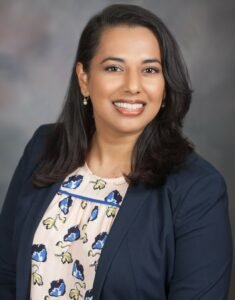March 2022 Society Spotlight
 Meet Amaal J. Starling, MD, FAHS, FAAN
Meet Amaal J. Starling, MD, FAHS, FAAN
People should be seen, their voices heard, their journeys honored, their struggles acknowledged, and their lives valued. Stigma is the biggest barrier in invisible diseases, such as migraine. As a person with migraine myself, this was not a barrier that I could ignore, but rather one I chose to dismantle piece by piece.
As a neurology resident, I volunteered to see every patient that presented with headache as a symptom, and soon found myself with a resident clinic full of headache disorders, mostly migraine of course. I did this because I wanted these patients to be seen, heard, and valued, but I quickly found this patient population to be some of the strongest, most inspiring people that I knew—WARRIORS. As the patient population captured my heart, the science fascinated my mind, and I was destined to become a headache medicine specialist—I haven’t looked back.
I was fortunate to have Dr. David Dodick, a leader and advocate in headache medicine, as my neurology residency program director who provided me with unparalleled mentorship and sponsorship. He helped me manage patients with refractory disease and included me in scholarly activity. He encouraged me to join the American Headache Society (AHS) and to start attending the Scottsdale Headache Symposium and the Annual Scientific Meeting.
Patient care brought me to headache medicine, but the American Headache Society has provided me with the infrastructure for a meaningful career. At my first AHS meeting, I recall Dr. Dodick recommending that all members join Special Interest Sections to get involved and engaged with AHS—so I joined every single Special Interest Section (SIS)! The advice was accurate—I got involved! My only concern was that meeting times were overlapping, so I couldn’t attend every SIS meeting. Under the leadership of Dr. Tesha Monteith, the New Investigator and Trainee (NIT) Special Interest Section was an amazing environment of passionate emerging leaders in headache medicine. I was fortunate to be elected as Chair of the NIT Section by my peers. This was my first leadership role in a professional society and it was full of growth.
Going back to the invisible, it is easy to feel invisible when you are a trainee and do not know a lot of people at meetings. As the NIT Section Chair, I wanted trainees to be more engaged. The NIT Section and I had a vision to offer a trainee membership, host mentorship sessions, have dedicated time for trainee presentations, and offer courses designed for trainees and new investigators. AHS leadership guided the NIT Section to success in efforts to elevate the role of the trainee in AHS. This has expanded exponentially over the last 10 years. AHS is a very trainee-centered organization.
As AHS expanded its digital footprint, I had the opportunity to join the Electronic Media Committee and eventually serve as Chair. This, again, was an avenue to increase the awareness of the invisible disease of migraine, decrease the stigma of headache disorders, and highlight the work of headache medicine clinicians and scientists through social media and electronic content. This has been a space where I have learned the great power of not only words, but also images, in how diseases are reframed and an organization is perceived. AHS is an inclusive, supportive environment aimed at improving the lives of people living with headache disorders through education, mentorship, and advocacy.
Through my work with AHS, the American Migraine Foundation, and the Alliance for Headache Disorders Advocacy, advocacy has become my antidote for burnout. As the inaugural chair of the AHS Advocacy Committee, we have increased the involvement of AHS in multiple advocacy campaigns and events. Ranging from successfully receiving Center of Medicare Services coverage for oxygen for cluster headache to opposing legislation that would make it harder for clinicians to practice evidence-based care to increasing the number of healthcare professionals and AHS members at the annual Headache on the Hill event—the Advocacy Committee has played an essential role. We aim to encourage, educate, guide, and provide a framework for AHS members to participate in health advocacy.
Health advocacy includes work in diversity, equity, and inclusion where we can address health inequities through the who, what, where, and when of AHS activities. It is an honor and privilege to serve on the AHS Diversity, Equity, and Inclusion Taskforce, which prioritizes inclusion to enhance the leadership and membership of AHS to work towards equitable care. We have several ongoing initiatives that will deliver measurable changes with respect to equity and inclusion in AHS and the field of headache medicine.
Through advocacy, we can turn today’s barriers into tomorrow’s solutions. I am thankful to be a member of an organization that believes in making the invisible visible, in the work that needs to be done in healthcare equity, and inclusion. Together, we are migraine warriors.
I hope to see you at the upcoming 64th Annual Scientific Meeting, maybe at a Special Interest Section Meeting!
Amaal Starling, MD, FAHS, FAAN
Associate Professor of Neurology
Program Director, Transitional Year Residency
Department of Neurology
Mayo Clinic
Twitter: @AmaalStarlingMD


